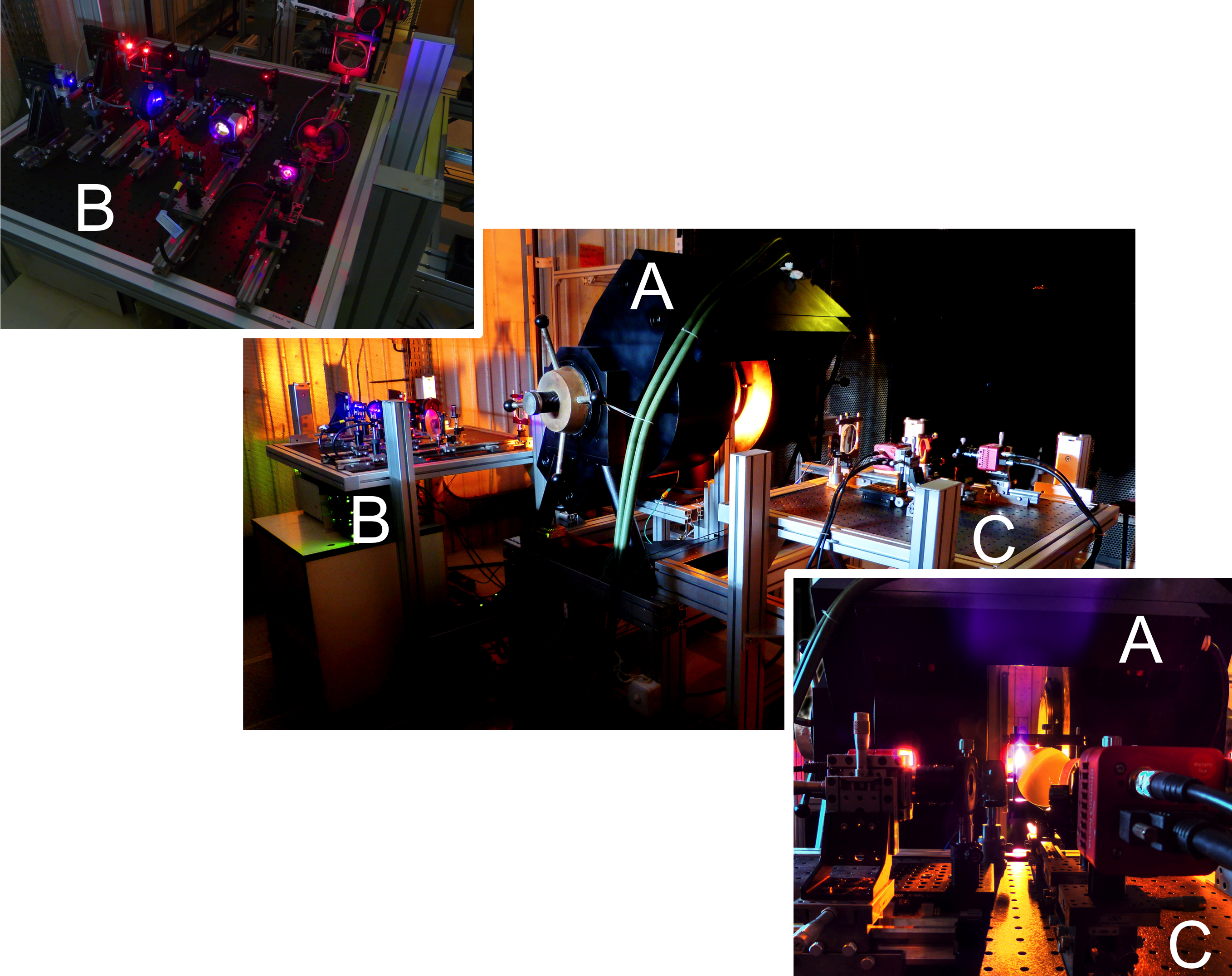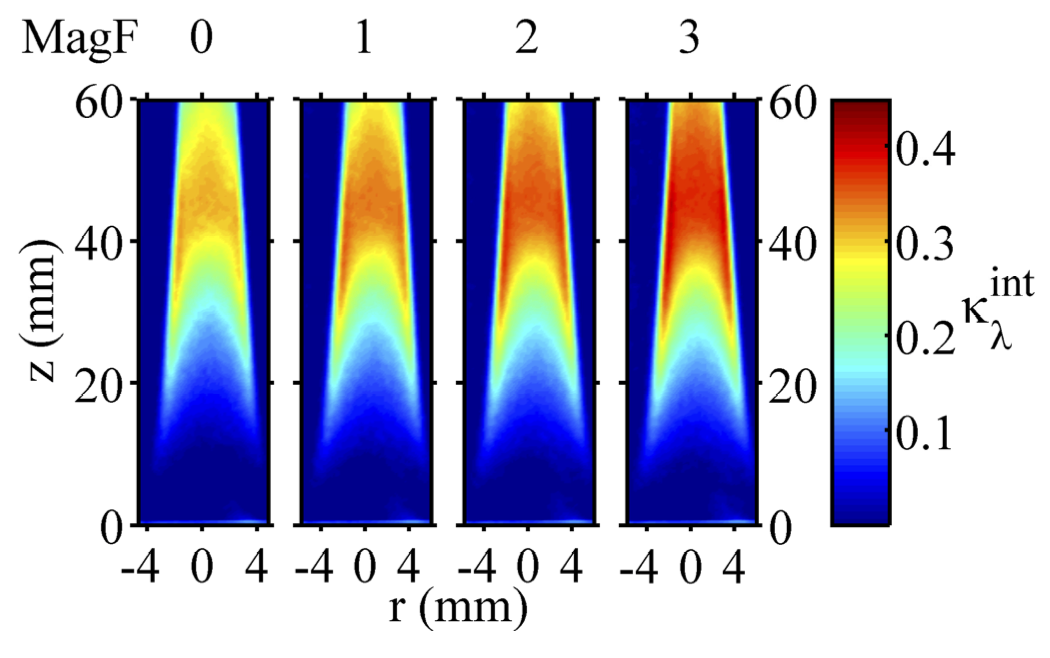Follow here the studies that aim at the magnetic control of combustion characteristics.
This project is a collaboration with Pr H. Pitsch and Pr. T. Gomez.
Recent related publications:
G. Legros, T. Gomez, M. Fessard, T. Gouache, T. Ader, P. Guibert, P. Sagaut, and J.L. Torero. Magnetically induced flame flickering.Proceedings of The Combustion Institute, 33:1095–1103, 2011 [link].
A. Jocher, H. Pitsch, T. Gomez, and G. Legros. Modification of sooting tendency by magnetic effects. Proceedings of The Combustion Institute, 35:889–895, 2015 [link].
A. Jocher, J. Bonnety, H. Pitsch, T. Gomez, and G. Legros. Dual magnetic effects on soot production in partially premixed flames. Proceedings of The Combustion Institute, 36:1377–1385, 2017 [link].
A. Jocher, H. Pitsch, T. Gomez, and G. Legros. Combustion instability mitigation by magnetic fields. Physical Review E, 95:063113, 2017 [link].
A. Jocher, J. Bonnety, T. Gomez, H. Pitsch, and G. Legros. Magnetic control of flame stability: application to oxygen-enriched and carbon dioxide-diluted sooting flames. Proceedings of The Combustion Institute, 37:5637-5644, 2019 [link].
Rationales
The growing concerns about increasing energy demand, energy efficiency policies, energy security issues, hazardous effects of combustion-related emissions on human health, and global warming change have led to more and more stringent regulations on exhaust emissions from combustion devices, and especially on soot release.
Standard strategies of soot production control involve post-treatment methods, such as filters and/or catalysts. However, using in situ strategies looks like an increasingly promising method. Examples are the design of new fuels, addition of exhaust gases to the combustion process, or combustion control by electrical fields. Interestingly, none of these strategies utilises magnetic fields.
Among the species contributing to the combustion process, O2 and OH exhibit relatively high paramagnetic susceptibilities. Yet the magnetic force acting on this kind of species per unit volume can be expressed as follows:

where χi is the species magnetic susceptibility per unit mass, Yi its local mass fraction, ρ the local density, μ0 the vacuum magnetic permeability, and B the magnetic flux density. In the follwoing, the gradient of B2 is referred to as magnetic gradient. As a result, in the presence of a non-uniform B field, one can then expect the additional magnetic force to play a role in selective transport phenomena. In addition, O2 and OH are considered as highly soot-oxidzing species. For this reason, we have investigated the influence of magnetic fields in sooting flames for a few years.
Works at ∂'Alembert
The configuration of the burner is the so-called Santoro one. This is a laminar axisymmetric coflow burner that is largely documented in the literature related to soot production. The pictures shown in Fig.1 introduce the experimental setup that has been developed at Inst. ∂'Alembert to allow the investigations to be conducted.

Figure 1: experimental arrangement for the investigations on the influence of magnetic fields on sooting flames. A: electro-magnet; B: emission optics enabling the Modulated Absorption/Emission technique; C: collection optics. The inserts in the upper left and lower right corners show close-up views on B and C, respectively. The flame established over the Santoro axisymmetric coflow burner can be seen in the background of the insert in the lower right corner.
For the results presented here, the fuel stream, consisting of pure ethylene (C2H4), flows through the vertical axial brass duct, which has an effective diameter of injection of 11 mm. The coflowing oxidizer mixture is introduced into a concentric brass cylinder of 102 mm inner diameter. The oxidizer consists of a O2 and N2 mixture. Two mass flow controllers enable the variation of the oxygen molar content, XO2, in the oxidizer stream. Over the range of investigated flow rates, both fuel and oxidizer flows are steady and laminar at the height of the burner tip. In order to expose the flames to fairly uniform upward magnetic gradient, the burner tip is located 0.13 m below the coils axis of symmetry (see Fig.1). The magnitude of the magnetic gradient can be adjusted from 0 to 18.2 T2/m when setting the DC electrical current I that flows through the turns that constitute each coil.
Within the context of these works, the soot temperature and volume fraction fields are mapped by the Modulated Absorption/Emission (MAE) technique, that has been specifically developped at ∂'Alembert for two-dimensional axisymmetric flames. Figure 1 shows the optical arrangement (B) to deliver two collimated laser beams at two different wavelengths. These beams will cross the flame and the altered beams will be collected on two cameras (C). The absorption of every beam can then be evaluated, which is deconvoluted to yield the local soot volume fraction field. In addition, the local spectral emission rates can be inferred from the flame's emission at both wavelengths. The ratio of both spectral emission rates yield the local temperature field throughout the flame provided that soot is present. Thus, mapping soot temperature with MAE does not require any model correlating soot volume fraction and local spectral absorption coefficient. Only the measurements of the latter at two different wavelengths are required to enable the self-calibration of the technique and infer soot temperature from the ratio of the local spectral emission rates. Thus, the issue of the large discrepancies in the wavelength-dependent soot refractive index reported in the literature does not arise.
Figure 2 illustrates how the magnitude of the magnetic gradient can influence the soot production in the non-premixed flame where ethylene burns in air. As the magnitude of the upward magnetic gradient is increased, the raw extinction coefficient, which represents the optical density along the line-of-sight of the red laser beam, also increases, showing that more soot is produced in the flame. We showed that increasing the magnetic gradient monotonically actually enhances soot production for every oxygen content of the coflow in these non-premixed flames.

Figure 2: Maps of the raw integrated extinction coefficient measured with the red (645 nm) laser beam for increasing magnitude of the upward magnetic gradient, starting from 0 (MagF 0) to 18.2 T2/m (MagF 3). The ethylene non-premixed flame burns here in air. z=0 is the location of the burner tip.
To understand this observation, we can manipulate the formulation of the aforementioned magnetic force per unit mass. Due to the linear dependency on the species mass fraction, one can attribute the major contribution of the magnetic force to O2. This then leads to the following expression of the magnetic force:

where the superscript (∞) indicates the conditions away from the flame. This latter expression looks very similar to the formulation of the buoyant force below:
![]()
g being the gravitational acceleration.
Thus, the presence of a magnetic gradient can initiate and sustain a so-called thermo-magneto convection, which is here opposed to buoyancy as the magnetic gradient points upwards. For relatively long flames, buoyancy plays an important role. However with increasing magnetic gradient, the thermo-magneto convection is enhanced. Consequently the global residence time inside the flame is increased with increasing magnitude of the magnetic gradient. As a result, soot formation which exhibits a relatively long charateristic time is promoted.
Interestingly, similar trends have been reported in non-buoyant non-premixed sooting flames, which further supports the above reasoning about the balance between buoyancy and thermo-magneto convection.
Prospects
In the literature, one can find evidences of close correlations between soot production and flame stability. In the coming months, we will investigate the potential of the magnetic effects to influence the stability domain of flames.